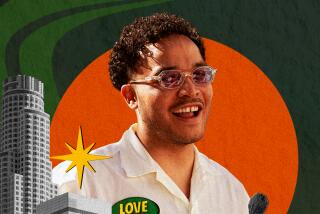Teaching Latinos to Buckle Up, Restrain the Kids
- Share via
Working undercover on a Santa Ana street corner, the two employees from Latino Health Access are under orders to monitor traffic.
They are not looking for red-light runners or speeders.
Health workers Rubi Gonzalez and Moises Vazquez are watching for drivers whose children are not in their car seats.
The unique observation is part of a Spanish-language car-seat program launched by Latino Health Access, a Santa Ana nonprofit that seeks to promote health through community projects.
Observation studies are used infrequently because they are time-consuming and imperfect, experts say. But they applaud the effort and hope it will provide some scope of a problem believed to be plaguing Santa Ana, which has the highest concentration of residents who speak Spanish primarily of any major city in the country.
“We are getting a baseline on car-seat use in Santa Ana, as an idea of car-seat use in low-income areas,” said Patricia Cantero, director of program evaluation. “We want to know what the barriers are that our community faces.”
The energetic workers are working with a $95,000 grant from the Children and Families Commission, which was created by Proposition 10.
By January, the workers will be conducting surveys with city residents and conducting neighborhood discussions, or platicas, about car seats. They will then tour apartment complexes to teach proper car-seat installation and give car seats to residents who owned seats that have been recalled.
Although no study has been done in Santa Ana, a nationwide tally by the National Highway Traffic Safety Administration shows car crashes are the leading cause of death for Latinos under the age of 44. The largest contributor, the study found, was a disregard for seat belt and car-seat laws.
A 1998 John Hopkins University study showed Latino children under 12 had a 72% greater probability of dying in a car crash than non-Latino children. More than 60% of the children who died in motor vehicle crashes were unrestrained.
“To reach new immigrants is a challenge, particularly people who are not documented,” said Jose Ucles, spokesman for the National Highway Traffic Safety Administration. “Hispanic families are, in some instances, of less means with larger families and [drive] older cars. It’s a set of situations that are difficult.”
Theories abound on why car-seat use has been slow to catch on in Latino communities. Few states in Mexico have car-seat laws, meaning many immigrants aren’t familiar with the requirement. The seats aren’t cheap, they take up space, and they are inconvenient for families who share rides with others.
Whatever the reason, Gonzalez knows the problem firsthand just from watching cars on the streets of Santa Ana.
Standing on a street corner recently, Gonzalez peered into the passing cars, watching as young children stood up or jumped around inside the car, all clear violations. In one case, a child riding in a car seat tipped over as the car made a turn.
“We know they love their kids, but what we are seeing is a lot of parents who don’t even have car seats,” Gonzalez said. “They don’t even use seat belts.”
California law requires children up to 6 years old or less than 60 pounds to be in a car seat. The seat must be tightly strapped down with a seat belt.
Gonzalez and Vasquez previously worked as translators at car-seat events conducted at Children’s Hospital of Orange County. But they and others at Latino Health Access said they wanted to work directly with the Latino community and became certified car-seat technicians through the National Highway Traffic Safety Administration.
Conrad Gonzales, safety program director at National Latino Institute in San Antonio, Texas, said the Latino Health Access program is important because there are few Spanish-speaking technicians in the country. There are so few Spanish-speaking technicians that he has been asked to give classes in Arkansas, New York, Arizona and other states with new immigrant populations.
“There are people all over who don’t use belts or seats. But immigrants can have greater problems. When they come to the United States, they are used to not having car seats or even their seat belts in. People think ‘I’m just going a few blocks’ ... or they think ‘It won’t happen to me,’ ” Gonzales said.
In addition, there are few materials in Spanish. Even those materials in Spanish “don’t speak” to immigrants because the translations are so poor, Gonzales said.
Fausto Villalobos, another Latino Health Access worker, said many low-income families buy car seats at garage sales, which he said is a dangerous practice because of the possibility the seat has been in an accident or is equipped with straps that no longer work.
“A lot of them think car seats are just for little babies,” Rubi Gonzalez said. “It’s up to us to get the word out, in Spanish, about how they can do what they want anyway, which is to protect their children.”
More to Read
Sign up for Essential California
The most important California stories and recommendations in your inbox every morning.
You may occasionally receive promotional content from the Los Angeles Times.













